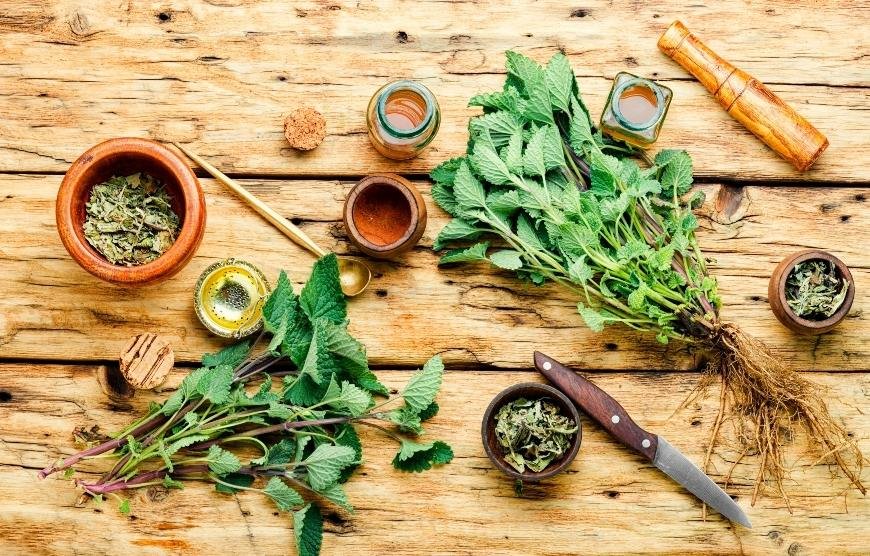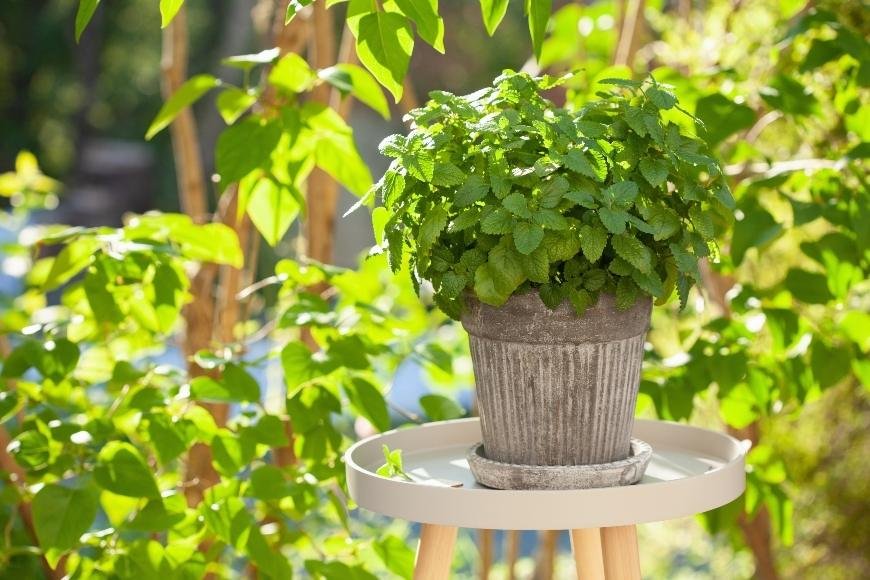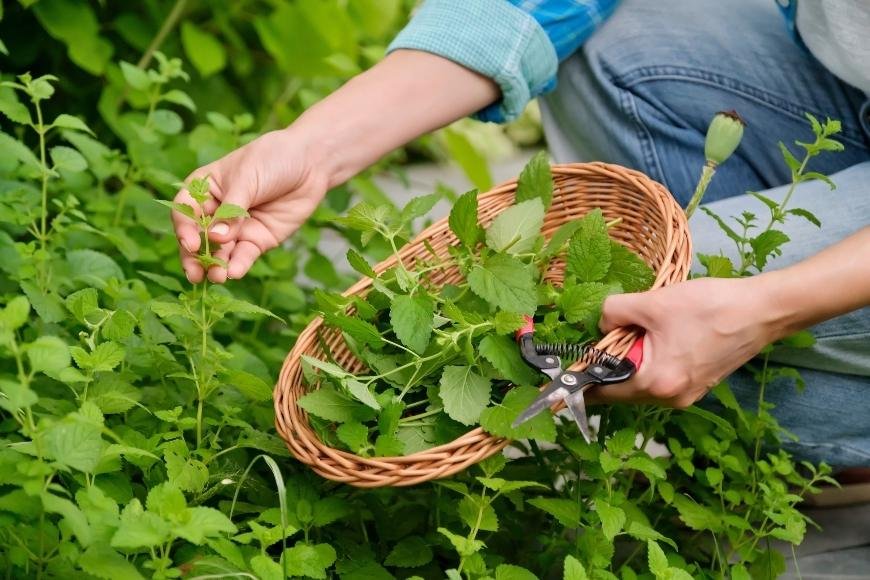How to Grow Lemon Balm
Learn how to grow lemon balm with our easy guide, perfect for young adults. Master planting, watering, and harvesting this calming herb today!

For those just starting out or already experienced with gardening, lemon balm is a great choice for cultivating due to its pleasant aroma and versatility. Lemon balm plants are not only a delight for the senses but also possess numerous medicinal properties that can help alleviate anxiety and promote relaxation.
In this comprehensive guide, we will delve into the various aspects of growing lemon balm successfully. From choosing the perfect location to planting, watering, fertilizing, pest control, and finally harvesting those aromatic leaves - we've got you covered.
Whether you're planning on growing your lemon balm indoors or outdoors during its preferred growing season, our expert tips will ensure that your plant responds optimally to its environment. So let's dive in and explore the world of lemon balm cultivation together!
Table of Contents:
- Choosing a Location
- Sunlight Exposure
- Soil Type & Drainage
- Space Considerations
- Planting
- Watering
- Fertilizing
- Pest Control
- Harvesting
- Frequently Asked Questions How to Grow Lemon Balm
- Conclusion
1. Choosing a Location

Growing lemon balm requires careful consideration of the location where you'll plant it. This versatile herb thrives in various conditions but prefers certain environments for optimal growth and potency. To ensure your lemon balm flourishes, consider factors such as sunlight exposure, soil type, and drainage.
Sunlight Exposure
Lemon balm enjoys full sun or partial shade; however, too much direct sunlight can cause its leaves to lose their vibrant green color and essential oils that contribute to its unique aroma and flavor profile. Ideally, choose a spot that receives at least 4 hours of direct sunlight daily or dappled light throughout the day. If you're growing indoors using artificial lighting like LED grow lights, make sure they are placed at an appropriate distance from the plants.
Soil Type & Drainage
The ideal soil for lemon balm is well-draining with a pH between 6 and 7. A loamy or sandy-loam mixture works best since it retains moisture without becoming waterlogged easily – which could lead to root rot problems down the line.
- Loamy Soil: A balanced mix of sand, silt, and clay that provides good drainage while retaining nutrients.
- Sandy-Loam Soil: A soil mixture with a higher sand content for improved drainage but still holds onto some moisture and nutrients.
If your garden's natural soil doesn't meet these requirements, consider amending it with organic matter like compost or well-aged manure to improve its texture and nutrient content. Alternatively, you can grow lemon balm in raised beds or containers filled with high-quality potting mix designed for herbs (source).
Space Considerations
Lemon balm is known to spread quickly if left unchecked; therefore, ensure adequate space between plants when planting outdoors. Space seedlings approximately 18-24 inches apart to allow ample room for growth without overcrowding (source). If growing indoors or in containers, choose pots at least 12 inches wide and deep to accommodate the plant's root system as it matures.
When picking a site for your lemon balm, take into account the kind of soil and amount of moisture it requires. Having settled on a suitable location, it is time to begin planting your lemon balm.
2. Planting
Growing Lemon balm is an exciting journey, and it all starts with planting the seeds or seedlings. To ensure a successful growth process, follow these steps:
a) Choosing Seeds or Seedlings
First, decide whether you want to start your Lemon balm garden from seeds or seedlings. While both options have their pros and cons, starting with seedlings can save you some time as they are already partially grown.
b) When to Plant
The best time to plant Lemon balm is in the early spring when there's no more risk of frost. This allows your plants enough time to establish themselves before the summer heat kicks in. If you live in a region with mild winters, consider planting them during fall for an earlier harvest next year.
c) Preparing Your Soil
- Soil Type: Lemon balm thrives in well-draining soil that's rich in organic matter. You can improve your soil by adding compost or aged manure.
- pH Level: Aim for a slightly acidic pH level between 6 and 7 for optimal growth conditions.
- Tilling: Before planting, loosen up the top layer of soil using a fork or tiller so that it becomes easier for roots to penetrate deeper into the ground.
d) How Deep to Plant Seeds and Seedlings?
- Seeds should be buried around a quarter of an inch below the surface, with just a small amount of dirt covering them. Space seeds approximately 12 to 18 inches apart.
- For seedlings, dig a hole slightly larger than the root ball of your young plant. Gently set the seedling in, ensuring its depth is identical to what it was before. Fill in around the roots with soil and gently press down to remove any air pockets.
With proper planting techniques, you're well on your way to growing a lush Lemon balm garden perfect for recreational use or simply enjoying its delightful aroma.
Sowing lemon balm is a key factor in cultivating prosperous plants, ensuring that the greenery has sufficient room to flourish and prosper. Moving on, proper watering techniques are necessary for maintaining healthy growth of your lemon balm plants.
3. Watering
Proper watering is essential for the healthy growth of your Lemon balm plants. Maintaining the right balance of water is key to avoiding root rot and promoting healthy growth in your Lemon balm plants.
Finding the Right Balance
To ensure optimal growth, you should aim to keep the soil consistently moist but not overly wet. Lemon balm prefers well-draining soil, so if you find that water tends to pool around your plant after watering or rainfall, consider adding some organic matter like compost or aged manure to improve drainage.
Frequency of Watering
The frequency at which you'll need to water your Lemon balm depends on factors such as climate and weather conditions in your area. In general, younger plants require more frequent watering than established ones. During hot summer months or periods of drought, be prepared to increase the frequency of watering accordingly.
- Youthful Plants: For seedlings and young plants (up until about six weeks old), aim for daily light watering sessions.
- Mature Plants: Once established (after approximately six weeks), reduce the frequency of watering sessions down to once every two days during warmer months and even less frequently during cooler seasons when evaporation rates decrease.
Tips for Effective Watering
- Avoid Overhead Watering: To prevent fungal diseases from developing on leaves due to excess moisture exposure, use a soaker hose or watering can to water the base of your Lemon balm plants rather than using a sprinkler system.
- Water in the Morning: By watering your plants early in the day, you allow excess moisture on leaves to evaporate before nightfall, reducing the risk of fungal infections and diseases.
- Mulch: Applying a layer of organic mulch around your Lemon balm plants will help retain soil moisture and reduce evaporation. This not only helps maintain consistent soil moisture levels but also aids in weed suppression and temperature regulation.
In summary, proper watering is crucial for maintaining healthy Lemon balm growth. Ensure that you strike a balance between providing enough water while avoiding overwatering by monitoring weather conditions, adjusting frequency as needed, and following effective watering techniques such as those outlined above.
4. Fertilizing
Fertilizing your Lemon balm plants is essential to ensure they receive the necessary nutrients for optimal growth and production of their aromatic leaves. A regular fertilizing regimen is essential for a flourishing Lemon balm plant with plenty of fragrant foliage.
Type of Fertilizer
For Lemon balm, opt for a fertilizer with a high nitrogen content to promote leafy growth. Nitrogen encourages leafy growth, which is exactly what we want from our Lemon balm plants. A well-balanced organic fertilizer such as 5-5-5 all-purpose mix or fish emulsion works great for this purpose.
Application Schedule
The ideal time to apply fertilizer depends on the stage of your plant's growth:
- Seedlings: When transplanting seedlings into larger pots or directly into the ground, add some slow-release granular fertilizer at planting time.
- Mature Plants: For established plants, feed them every four weeks during their active growing season (spring through early fall). Apply liquid organic fertilizers like fish emulsion by diluting according to package instructions and watering around the base of each plant.
- In-Ground Plantings:If you're growing lemon balm directly in soil rich in organic matter like compost or aged manure, additional feeding may not be required since these materials can supply sufficient nutrients throughout the growing season.
Tips for Proper Fertilization
Here are some tips to ensure your Lemon balm plants receive the right amount of nutrients:
- Avoid over-fertilizing, as this can lead to excessive growth and reduced flavor in the leaves.
- Always follow package instructions when applying fertilizers. More is not always better.
- If you notice yellowing or pale green leaves, it could be a sign of nitrogen deficiency. In such cases, apply a high-nitrogen fertilizer to help restore their vibrant color.
Incorporating these fertilization practices into your Lemon balm care routine will result in healthy plants with an abundance of fragrant foliage that's perfect for all your herbal needs.
Fertilizing your lemon balm correctly is essential for healthy growth and a bountiful harvest. Pest control, however, is also an important part of keeping your plants safe from harm and ensuring their continued success.
5. Pest Control
Lemon balm plants are generally low-maintenance and resistant to many pests, but they can still fall victim to some common garden nuisances. To keep your lemon balm thriving, it's essential to implement natural pest control methods that won't harm the plant or diminish its medicinal properties.
Aphids
Aphids are small insects that feed on plant sap, causing leaves to curl and become discolored. You can easily remove them by spraying your lemon balm with a mixture of water and mild dish soap. Introducing helpful bugs, such as ladybugs, into your garden can be an effective way of controlling aphids since they enjoy snacking on them.
Spider Mites
Spider mites, tiny arachnids that cause yellowing leaves and webbing on plants, may also attack lemon balm. Like aphids, spider mites can be controlled using a soapy water spray or by introducing predatory insects such as lacewings or ladybugs.
Caterpillars
- Bacillus thuringiensis (Bt): This naturally occurring soil bacterium is an effective way to combat caterpillar infestations without harming other organisms in the process. Simply mix Bt with water according to package instructions and apply it directly onto the affected lemon balm leaves.
- Diatomaceous Earth: Another natural pest control method, diatomaceous earth is a powder made from fossilized algae that can be sprinkled around the base of your lemon balm plants. Diatomaceous earth is a powder formed from fossilized algae which, when applied around the base of your lemon balm plants, can cut into the exoskeletons of crawling insects such as caterpillars and cause them to dry out.
- Hand-picking: If you spot any caterpillars on your lemon balm plants, simply remove them by hand and dispose of them in soapy water or relocate them far away from your garden.
Maintaining a healthy growing environment for your lemon balm will help prevent many pests from becoming an issue. Regularly inspecting the plant's leaves and stems for signs of infestation will allow you to address problems early before they become severe.
7. Harvesting

Growing Lemon balm is a rewarding experience, especially when it's time to harvest the fruits of your labor. Knowing when and how to gather the herb is essential for gaining its full benefits while keeping it healthy for future harvests.
When to Harvest
Harvesting Lemon balm leaves at their peak flavor and potency should be done before they start flowering, typically in late spring or early summer. This is when the plant's essential oils are at their peak concentration, providing maximum flavor and potency. However, if you miss this window, don't worry - Lemon balm can still be harvested throughout its growing season as long as there are enough healthy leaves remaining on the plant.
How to Harvest
- Select healthy leaves: Choose vibrant green leaves without any signs of yellowing or damage from pests.
- Cut carefully: Use clean pruning shears or scissors to snip off individual stems about an inch above ground level. Be sure not to remove more than one-third of the total foliage at once; over-harvesting can weaken your plant and reduce future yields.
- Rinse thoroughly: Gently wash harvested leaves under cool running water to remove dirt and debris before using them fresh or preparing them for storage.
Tips for Maximizing Your Harvest
- To encourage bushier growth and increase yield potential, regularly pinch back new shoots during early stages of development by removing approximately one inch from the tips.
- Prune your Lemon balm plants back by one-third in mid-summer to stimulate new growth and extend the harvesting season.
Storing Your Harvest
Properly storing your harvested Lemon balm leaves will ensure they maintain their flavor and potency for future use. There are several methods you can employ:
- Air-drying: Tie small bundles of stems together, hang them upside down in a well-ventilated area away from direct sunlight, and allow them to dry for about two weeks or until completely crisp. Once dry, strip the leaves from their stems and place them in an airtight container.
- Oven-drying: Spread clean leaves on a baking sheet lined with parchment paper, set your oven to its lowest temperature setting (around 150°F/65°C), and leave the door slightly open. Check periodically until leaves are fully dried - this should take approximately two hours depending on humidity levels.
- Freezing: For longer storage without sacrificing much flavor or potency, place washed leaves into resealable plastic bags or containers before freezing. They can be used directly from frozen state when needed.
Frequently Asked Questions How to Grow Lemon Balm
How hard is it to grow lemon balm?
Growing lemon balm is relatively easy, as it's a low-maintenance plant that thrives in various conditions. It prefers well-draining soil and can be grown from seeds or cuttings. With proper care, including regular watering and occasional fertilizing, you'll have a healthy lemon balm plant.
Does lemon balm grow back every year?
Yes, lemon balm is a perennial herb that grows back each year. In colder climates, the leaves may die off during winter but will regrow once temperatures rise again in spring.
How long does lemon balm take to grow?
Lemon balm typically takes around 60-70 days to reach maturity when grown from seed. However, if you start with an established plant or cutting, it will mature faster and can be harvested within just a few weeks of planting.
How do you grow and harvest lemon balm?
To grow lemon balm successfully: choose a suitable location with partial shade; prepare the soil by adding compost; sow seeds or transplant cuttings; water regularly without overwatering; apply organic fertilizer occasionally; monitor for pests like aphids. Harvest young leaves throughout the growing season by snipping them off near their base as needed.
Conclusion
Growing lemon balm is a rewarding experience that can be enjoyed by all. With suitable conditions and the application of appropriate cultivation, watering, fertilizing and pest control methods, you can ensure a successful harvest of lemon balm. When it comes time for harvesting this fragrant herb remember to do so in moderation as too much of it could cause an unpleasant taste. With proper care and attention you should find success with growing lemon balm.


































































































































